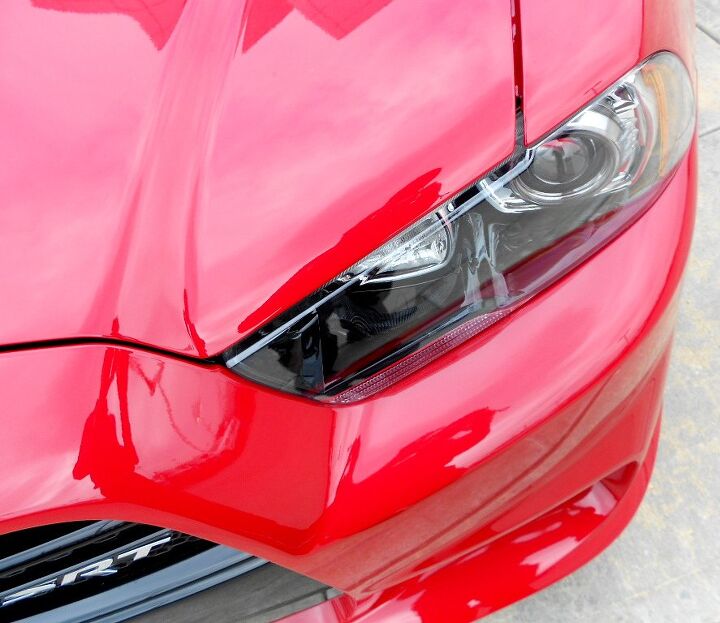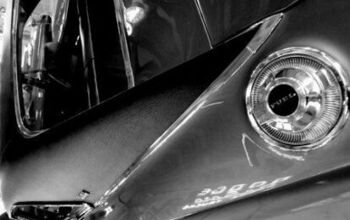Vellum Venom: 2013 Dodge Charger SRT

@willstpierre tweets:
@SajeevMehta Art history teacher talked about using vellum today. Nobody else knew what it was
While Ford and GM pissed away decades of heritage for horribly demure (yet disturbingly plump) full size sedans built on a namby pamby FWD globalized chassis, Chrysler took the hard points of the Mercedes-Benz W211 sedan to make America’s one and only four portal bad motherfu*ker.
Get used to this face, because it’s today’s American Bad Ass Sedan.
Pardon me while I remain infatuated with the SRT’s perfect use of subtle bends to make a seriously muscular nose. The phrase “power dome hood” has been around for decades, but this fascia earns that title many times over.
The hood and fenders meet logically, elegantly against the slender headlights. While the bulldog grille accentuates the nose’s massive flatness, the Charger SRT asserts itself like no other machine in its class.
This design feature (assuming it’s radar cruise control) is far from invisible on the Charger’s facade, but at least the horn-shaped bezel complements the lower bumper’s curvature.
The wave at the bottom of the bumper bends harmoniously with the fog light surround and the grille’s teethy edge. The high spot over the foglight needs a belt sander, but this is a super hormonal family sedan by design. And it still looks the part without being cartoonishly overstyled like a C7 Corvette.
Dodge’s signature grille looks great: the original Viper started it and kudos to Chrysler for not blowing it with a switch to something less recognizable. The four pointed grille takes on a new dimension with the honeycomb treatment inside the “star”, proving this design stands the test of time by never remaining stagnant.
If only the other American brands (except Cadillac) could make a grille design and stick with it. Too bad about that.
Brand honesty is a great thing, but a tall and flat truck-y nose is not. This design would be amazing on the sleek beak of an old school Plymouth Fury. No matter, the face is suitably modern muscle car angry. And the staggered headlight sizing is the icing on the cake.
There’s an oh-so-subtle straightening of the wheel well arch as it meets the aggressive flaring of the front bumper. Man, now THAT is trick.
While unstoppable on a slender ’70 Fury, the Charger SRT’s gaping maw needs the shadows of black paint to compensate for this much real estate. But still, look at the power dome hood’s hustle and flow as it sweeps to the windshield! The number of shadows on the hood (like the hard bend at the center of the hood, and the matching bends at the ends of the fenders) shows great attention to detail on the modern muscle car theme.
So many fast, long and flowing lines. And none fight with each other! Note the negative area needed for the hood scoop: there’s plenty of space to make a name for itself (i.e. unique shapes) on the Charger’s vellum.
Another bonus: the hood scoop’s honeycomb is wide open: no solid blocks of cheapness here.
Could this be a late 4th Generation Camaro? No matter, this gives the Charger SRT even more street cred, since the Camaro is now a plump tribute to the first generation of Chevy’s Pony Car.
There’s a reason why that nose is painted black: it’s huuuuuge. The added contrast might remove visual bulk, but the middle band (the part below the grille, above the valence) needs body color paint instead.
Six point four liters of REPRESENT: no greenwashed pretensions like Ford’s Ecoboost V6 (formerly and rightly called TwinPower), no excuses given. It’s just another American bad ass, right?
With our last installment in mind, the Charger’s elegant side cove comes correct. While far cooler if the cove started on the fender (like a C5 Vette) it’s still a nice touch considering the height and visual heft of today’s sedans.
Clean integration of the wiper arm and cowl cover. Nice.
The American Bad Ass has no DLO FAIL.
NONE, SON.
Such a perfect meeting of A-pillar, fender and front door! And to everyone else: how frickin’ hard is this to make? No excuses, just do it!
Even the panel gaps are close enough to perfect. This is how you craft a sedan!
The black Charger nearby highlighted the door cove’s flowing lines as it reaches the C-pillar. Sure, like all new cars, it’d be nice to section 1-3 inches of door sheet metal to lower the body and visually lengthen it…perhaps one day we will get that design aesthetic back.
Like the A-pillar, the B-pillar is sleek and clean. The black trim always helps integrate the glass into the rest of the body: necessary when your greenhouse is sleek, fast and a bit on the skinny side.
Not so great at the C-pillar: the greenhouse ends in a BMW-style Hofmeister Kink, but the door’s cut line refuses to play ball. Instead of continuing the natural curve, it bends backward before repeating the kink’s curvature. Quite static and sad for a muscle car, actually.
But there’s nothing but love for the black-chrome SRT rimz with Brembo stoppers.
Apparently the SRT brand has some curb (rash) appeal. Literally.
Gas filler door bisects the quarter panel with elegance and symmetry. Nice.
Aside from the usual complaints about sky-high belt lines, huge flat buffalo butts and the need for dubs to fill the gap…well, the Charger still has a nice profile. I’d lose that spoiler in a heartbeat: it accentuates the buffalo butt.
The door cut line and that Hofmeister kink look fine from here, even if they are too slow or static. The tapered C-pillar works well with the obligatory muscle car fastback roof line, but it’s a shame the lower half (i.e. the quarter panel) lacks tapering (inwards) to match.This touch helps tremendously in reducing automotive buffalo butt.
Still, this sedan is a looker. The flat door handles look great, and there’s no DLO FAIL. The flat edge at the rear window gives a little muscle, keeping it from looking flabby. Just a little more tumblehome at the B-pillar is all that’s needed for maximum style.
The C-pillar extends above the plane of the rear window. Perhaps it’s a hat tip to the earlier Chargers, and perhaps it does a fantastic job keeping this area from being too flat and boring.
But from this angle, the black plastic finish panel needs to go. Painted metal would look much cooler. Or just make the whole thing flush with the rear glass.
Naaaah. The effect is that of an American Bad Ass. Close enough to perfection for a mass-produced machine.
An elegant backside, provided one never steps back to notice the height and bulk.
A buffalo butt for sure, but the strong vertical cut line at the end of the tail light assembly isn’t without its charms. Too bad this Charger is so tall yet short on overhangs: more style from its 1960s forefather could complete the look.
That hard vertical cut line ends rather abruptly at the base of the bumper’s sweeping bend. A rounded edge is better than a 90-degree ending in this case.
I don’t believe an American Bad Ass needs ‘dem fancy ‘furrin diffusers on its bumper. Because this is a bit much.
Especially considering the super clean and recognizable-from-a-mile-away tail lights. The LED perimeter is a bit of old-school Detroit, from an era when beancounters had no say when a design studio demanded a feature, an era when insurance companies and beancounters didn’t dictate a vehicle’s design (expensive to replace full width lights)…so add the modest brand badging (aside from the dealership tattoo on top of the trunk) and the Charger SRT embodies many of the traits we love in American sedans.
In a modern tall+boxy package, sadly. With a warranty, gladly.
Thanks for reading, I hope you have a lovely week.

More by Sajeev Mehta
Latest Car Reviews
Read moreLatest Product Reviews
Read moreRecent Comments
- VoGhost Interesting comments. Back in reality, AV is already here, and the experience to date has been that AV is far safer than most drivers. But I guess your "news" didn't tell you that, for some reason.
- Doc423 Come try to take it, Pal. Environmental Whacko.
- 28-Cars-Later Mazda despite attractive styling has resale issues - 'Yota is always the answer.
- 28-Cars-Later Try again.
- Doc423 It's a flat turn, not banked, which makes it more difficult to negotiate, especially if you're travelling a little too fast.





































































Comments
Join the conversation
Supposedly, that's a "camera" rather than radar cruise control. It watches the road for cars that slow down in front of you too quickly and warns you with loud alarms that you have less than a second to start braking. It also goes off when it feels you're driving too fast on uneven terrain. My 300/Jeep have it.
The black one is identical to my daily driver Charger SRT8. Gonna be adding a custom tune and some drag radials in the spring to try and run some very low 12's with it (high 11's if I am lucky). Crazy part is according to the fuel efficiency computer I've been getting 29 MPG on the highway with it. The car does everything! A true Dr Jekyl - Mr Hyde in a cool wrapper. Regarding the rear window concave - its most certainly a hat tip to the 68-70 Chargers according to Ralph Gilles.